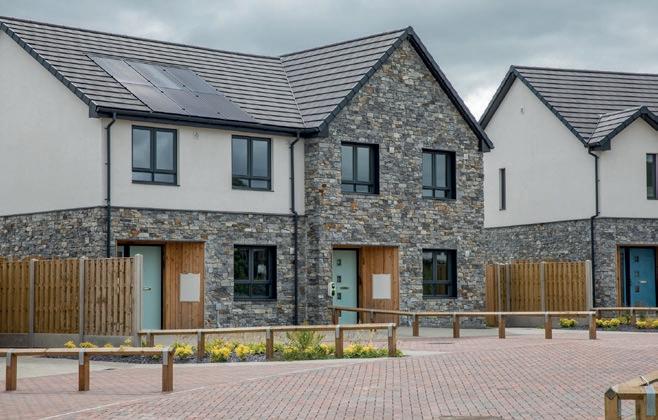
4 minute read
Resource management
Environmental Theme 8: Resource Management
Managing pollutants
The ongoing development of our environmental strategy will include managing and reducing pollutants. We actively seek to eliminate pollutants such as mould growth and water pipes containing lead through referrals from stock condition surveys. The cleaning products and paint that we use are disposed of via a sustainable licensed waste and recycling management facility when necessary.
Responsibly sourced building materials
When it comes to responsibly sourced materials, we want to exceed Welsh Government guidance. We’ve developed our standard specification to procure responsibly sourced materials. We have joined a decarbonisation framework with Travis Perkins which to date has seen:
94%
of waste
diverted from landfill
97%
of timber
purchased from certified sources (FSC - Forest Stewardship Council or PEFC - Programme for the Endorsement of Forest Certification)
This framework brings housing associations in North Wales together to use our collective bargaining power to achieve more responsibly sourced materials at affordable rates.
Where practically possible all building materials for new build projects are sourced locally or within a 30-mile radius of our development sites, which can be evidenced for our schemes at Hen Ysgol y Bont, Pentraeth, Mart Valley and Glasdir.
38%
carbon reduction
per £m of sales. Case Study – Glasdir
Glasdir is a group of 63 whole-life, EPC ‘A’ rated timber-frame, low-carbon homes. Delivered in partnership Welsh Government, Denbighshire County Council and Williams Homes, with partial funding through the Innovative Housing Programme. The project vision was to: Increase the number of well-designed, low-carbon, affordable homes in a semi-urban location. Creating a sustainable community and addressing fuel poverty.
Some examples of using responsibly sourced materials at Glasdir include:
A first in Wales we used MacRebur Tarmac. Replacing bitumen-based surfacing, it recycles 80,000 single use plastic bottles in every tonne of tarmac. Helping to tackle single-use plastics, it’s a proven product that’s harder wearing than traditional tarmac. The off-site manufactured timber frame and cladding uses homegrown Welsh timber, supporting local forestry supply chains. High-value timber markets from homegrown and local timber helps to support regional forest expansion, creating employment in rural forest industries.
This development showcases Foundational Economic thinking through the development of robust local supply chains. The procurement of local goods, trades and services meant 96% was sourced locally.
The triple glazing uses Recycled Composite Materials (RCM) which is manufactured from recycled waste PVC-U and is fully sustainable, as well as offering better thermal efficiency.
Our environmental strategy is under development with the waste management strategy being a key contributor to the overall environmental strategy.
We are conscious of our waste management through our planned works (kitchen and bathroom replacements) and responsive maintenance. We choose to use a sustainable licensed waste and recycling management facility for these operations, so we know that our waste is dealt with responsibly.
We’ve made arrangements for the doors that we remove for upgrading are reused by North Wales Police for training purposes.
On our new build schemes, we work with partners to complete a written declaration that all reasonable steps to reduce waste will be undertaken.
We continue to ensure that the Site Waste Management Plan (SWMP) is built into our procedures for consultants and contractors on site. This includes:
The target for the percentage content of waste re-cycled is 85% and is confirmed by recording outputs.
Consultants and contractors are aware of the requirements to have a Construction Site Waste Management Plan in place prior to commencement on site and must ensure they comply with all legislative duties to consider waste management within design and construction. Upon appointment of a contractor, a SWMP will be provided by ClwydAlyn and agreed prior to commencement on-site. Responsibility for the SWMP is the contractors, who has to expand and develop a plan in accordance with protocols and procedures, which are compliant with SWMP Regulations 2008. ClwydAlyn encourages the use of recycled material within new construction, or material reclaimed from the existing site or demolitions, or from off-site. However, materials must only be re-incorporated where technically appropriate and are of proven quality.
Prior to commencing works on site, the contractor must complete a written declaration that all reasonable steps will be taken to ensure that:
All waste from the site is dealt with in accordance with the waste duty of care in section 34 of the Environmental Protection Act 1990(3)
The Environmental Protection (Duty of Care) Regulations 1991(4); and materials will be handled efficiently, and waste managed appropriately.

We’ve started changing our fleet to electric vehicles. The key aims of our water management strategy:
Offer water butts into all new homes
Install grey water harvesting to recycle rainwater where possible
Water Regulations Advisory Scheme (WRAS) approved fittings to reduce water wastage in all new homes
All developments have Sustainable Drainage Systems (SuDS) to assist in flood alleviation
All homes free from lead water mains in the next 5 years
All homes fitted with new energy and water saving hot water systems within the next 10 years
All homes to have showers over baths within 5 years (where space permits)
We use our digital platforms to influence resident and community behaviour change, as well as working with our resident engagement team
Minimises water loss through preventative and control measures across our asset portfolio
Reduction of scope 1, 2 & 3 emissions, supported by our environmental 5-year plan
Deliver our Legionella policy supported by our in-house water hygiene technicians
Reduce water loss by attending to water leaks within 24hours
We’ll deliver our aims through a combination of our annual planned capital improvement program and reactive maintenance work. The plan is monitored through 12 monthly progress updates to our property committee.









